The Sandy Bridge Preview
by Anand Lal Shimpi on August 27, 2010 2:38 PM ESTAdobe Photoshop CS4 Performance
To measure performance under Photoshop CS4 we turn to the Retouch Artists’ Speed Test. The test does basic photo editing; there are a couple of color space conversions, many layer creations, color curve adjustment, image and canvas size adjustment, unsharp mask, and finally a gaussian blur performed on the entire image.
The whole process is timed and thanks to the use of Intel's X25-M SSD as our test bed hard drive, performance is far more predictable than back when we used to test on mechanical disks.
Time is reported in seconds and the lower numbers mean better performance. The test is multithreaded and can hit all four cores in a quad-core machine.
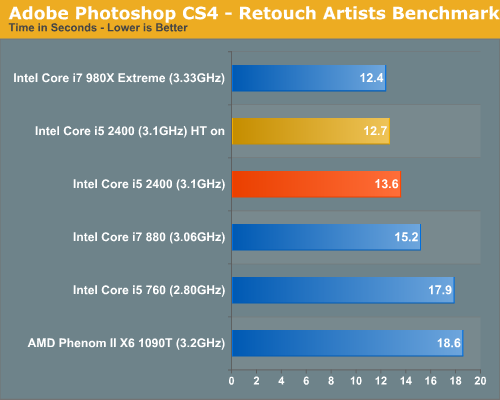
Right off the bat Sandy Bridge is killer. In our Photoshop test it’s faster than its closest quad-core price competitor, faster than its identically clocked Lynnfield, faster than AMD’s fastest and loses out only to Intel’s $999 Core i7 980X. That being said, it only takes about 9% longer to complete our benchmark than the 980X.
DivX 6.5.3 with Xmpeg 5.0.3
Our DivX test is the same DivX / XMpeg 5.03 test we've run for the past few years now, the 1080p source file is encoded using the unconstrained DivX profile, quality/performance is set balanced at 5 and enhanced multithreading is enabled:
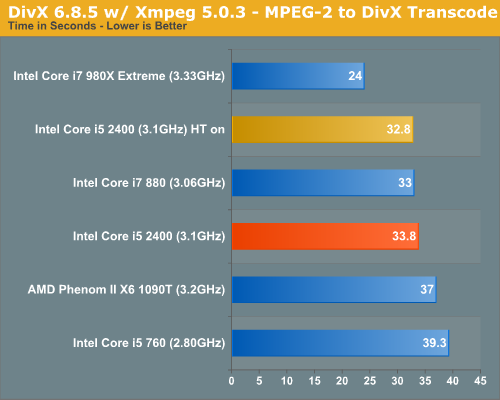
While not the most stressful encoding test, it’s still a valid measure of performance and once again, Sandy Bridge is faster than all. In this case we’re faster than the Core i5 760 (~16%) and just behind the Core i7 880. Clock for clock there's not a huge improvement in performance here (HT doesn't seem to do much), it's just a better value than the 760 assuming prices remain the same.
x264 HD Video Encoding Performance
Graysky's x264 HD test uses the publicly available x264 encoder to transcode a 4Mbps 720p MPEG-2 source. The focus here is on quality rather than speed, thus the benchmark uses a 2-pass encode and reports the average frame rate in each pass.
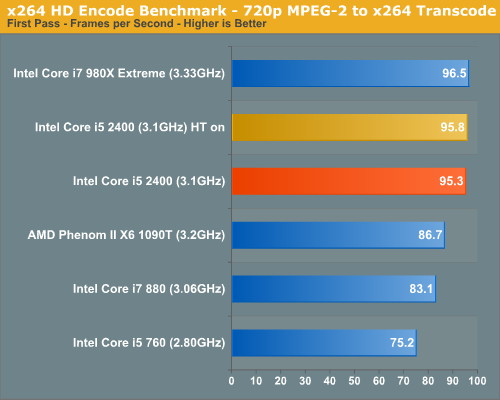
Lightly threaded performance is much improved - the 2400 is 14.6% faster than the Core i7 880.
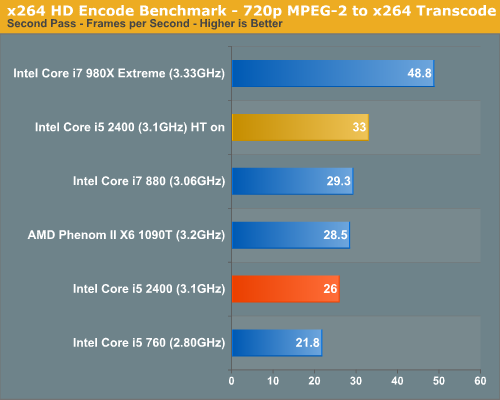
The actual encoding pass favors more threads, so we see a big improvement over the 760 (19%) but it falls short of the Core i7 880. Turn HT on and we get a 12.6% improvement over an identically clocked/configured Lynnfield.
Note that CPU based video encoding performance may not matter if Intel implemented a good video transcode engine in Sandy Bridge.
Windows Media Encoder 9 x64 Advanced Profile
In order to be codec agnostic we've got a Windows Media Encoder benchmark looking at the same sort of thing we've been doing in the DivX and x264 tests, but using WME instead.
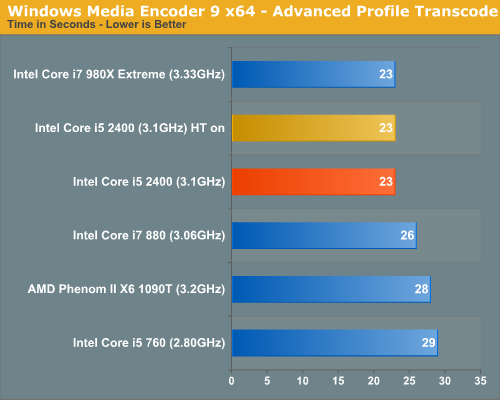
Performance in WME rarely scales anymore. Our benchmark doesn’t scale well beyond 4 cores and the only hope for performance are increases in clock speed or IPC. Sandy Bridge delivers the latter.
A 20% increase in performance vs. the similarly clocked 880 in a test that doesn’t scale with anything but IPC tells you a lot. Compared to the Core i5 760, Sandy Bridge is 26% faster.










200 Comments
View All Comments
Anand Lal Shimpi - Friday, August 27, 2010 - link
You're correct, I didn't feel a dual vs. quad-core comparison was fair which is why I focused on the 760. I'll clear up the text though :)Take care,
Anand
Anand Lal Shimpi - Friday, August 27, 2010 - link
fixed :)mastrdrver - Friday, August 27, 2010 - link
If we go with what Anand has said and use the roadmap to guess pricing I just have one question then:Why in the world would anyone spend ~$300 for the 2500 and ~$500 on the 2600 then use the on chip gpu with no plans on some kind of discrete?
If the difference between a $600 HP is Llano and Sandy Bridge, Llano has a possibly huge advantage since I think its safe to assume that the gpu side will start at 5450 performance.
Its like Intel would be trying to tell you that SD Xbox 360 is better than HD Xbox 360 (Llano). Are you serious? If Llano can hit a pc at that price point and have a full shader count, Sandy Bridge is dead in the consumer market.
I know that's a lot of ifs and time between here and then but Intel doing what it has always done with graphics (suck) is going to haunt it. I think Intel let the door wide open and its head between it and the frame. All AMD has to do is shut it.
DanNeely - Friday, August 27, 2010 - link
There are people whose workloads are heavily CPU bound but who don't need a heavy duty GPU. Higher end servers and a lot of workstations fall into this category.Beyond that unless Intel made a GPUless die or deliberately disabled the onboard GPU there's no reason not to include it. While we'll have to wait until Intel shows off labeled die shots I doubt that the GPU is a large enough chunk to justify the engineering effort just to save a little on the manufacturing side.
mastrdrver - Saturday, August 28, 2010 - link
You are correct but my point was meant to be on "Best Buy" systems and not server or workstations. Sorry if I didn't get that clear.On the server front this will have to go up against Bulldozer which is an entirely different topic.
While it would be foolish for Intel to make a gpuless die since integration with the cpu side is inevitable, Larabee or what ever better be good. Then there is the driver thing. That Dragon Age Origin picture sure doesn't look right. For drivers that still have work to do, that picture looks exactly like the one from when Clarkdale was released. I'd be a little surprised if much driver work is left if those two pictures are actually different.
arh2o - Friday, August 27, 2010 - link
How much will these new 1155 motherboard prices be? Will they be in the same price range as the current 1156 motherboards?Rajinder Gill - Saturday, August 28, 2010 - link
I'd imagine the P67 boards will be priced between $150~$200.odin607 - Friday, August 27, 2010 - link
What about temps =(cmdrdredd - Friday, August 27, 2010 - link
I'm never buying an Intel CPU or Motherboard ever again. This is one area that made them what they are today. The ability to take a mid range part and clock it up is what made the Core 2 series such a success with gamers and other performance enthusiasts. Not all of the success is attributed to overclocking, but a good bit of the popularity came from a $200 CPU being able to clock up to levels that the $700+ cpus hit. Now, if the unlocked parts can hit big overclocks and aren't overpriced then maybe it'll work out. However, it's all to easy for Intel to give us the finger and price a $200 CPU at $600 because it's unlocked and say "tough crap, if you want to overclock then pay up!". I am hopeful it doesn't come to this.Anyway, quads are old news IMO...I'm looking at 6core for my next one.
JumpingJack - Saturday, August 28, 2010 - link
"but a good bit of the popularity came from a $200 CPU being able to clock up" ...Reading the preview, it looks like the 2500K may fit this description.
From the articles:
"...and the 2500K will replace the i5 760/655K ($205 - $216). ..."
Even the 875K, when it launched, wasn't as you claim... it actually came in 200 bucks cheaper than the 870.
http://techreport.com/articles.x/18988
It would seem to me that Intel has been planning this change for sometime and went out to address this....